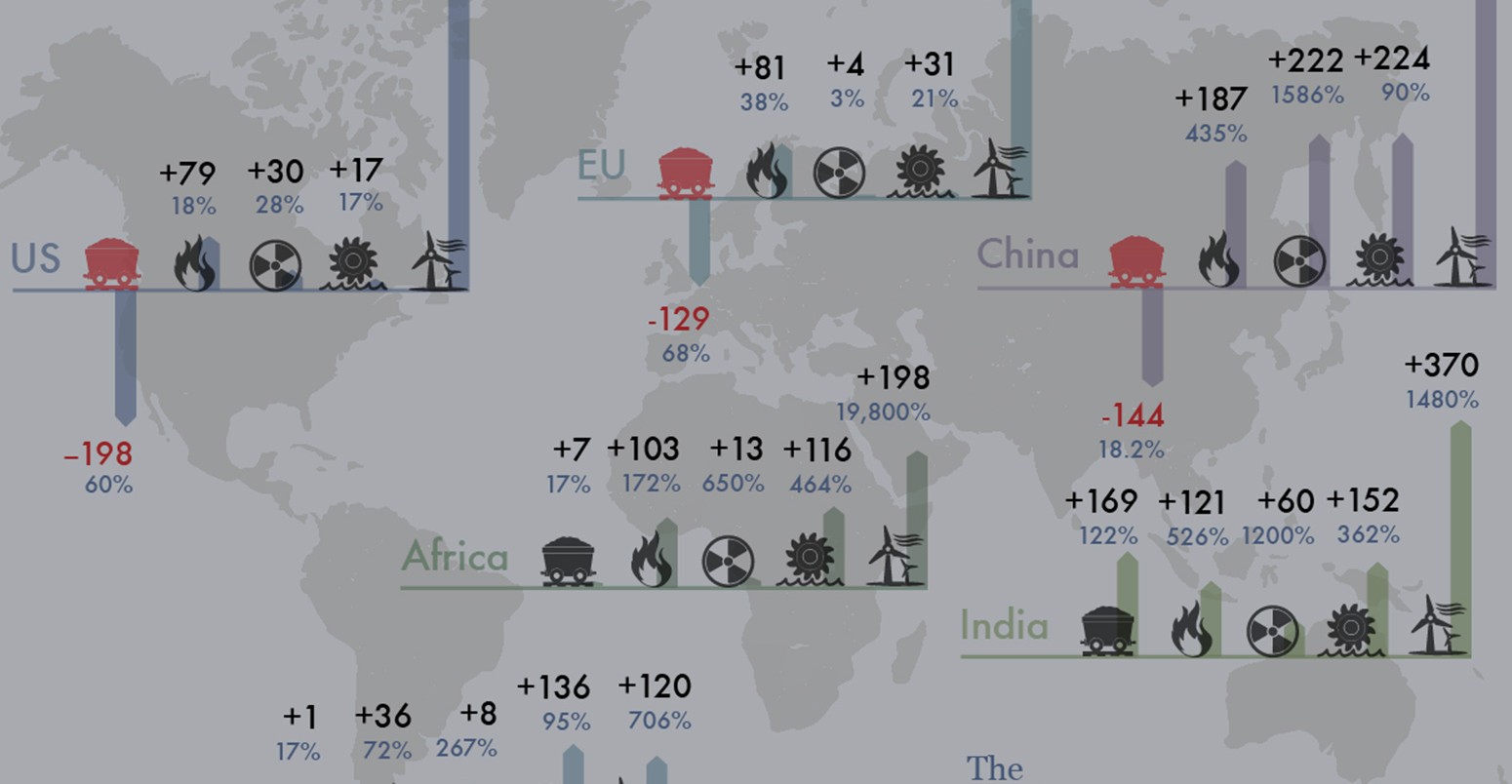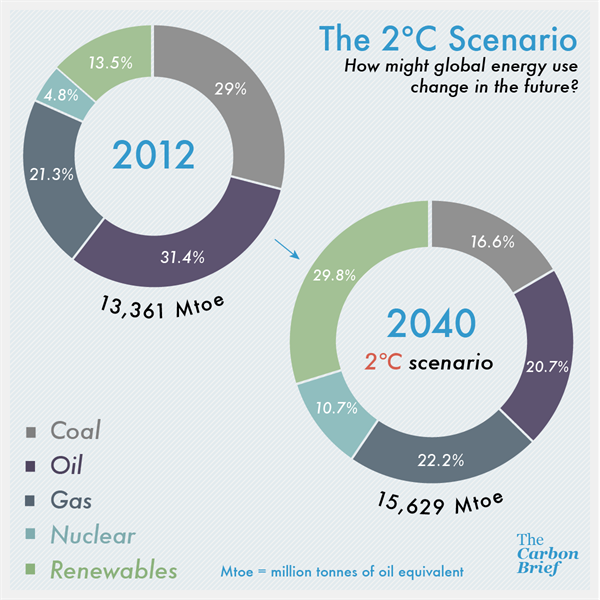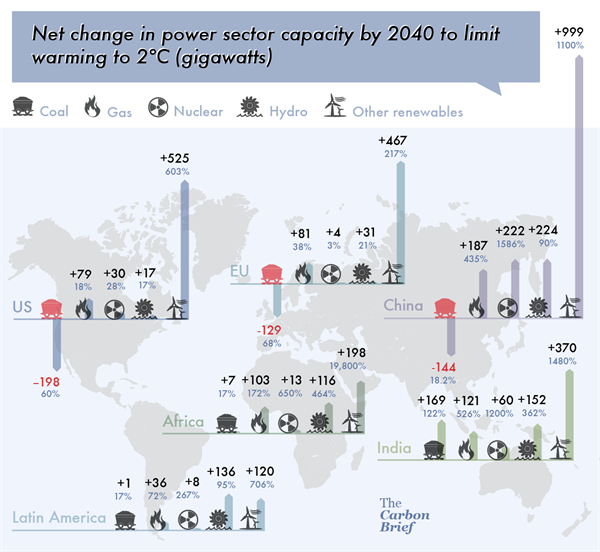
Two degrees: Will we avoid dangerous climate change?
Simon Evans
12.09.14Simon Evans
09.12.2014 | 11:30amLimiting warming to no more than two degrees has become the internationally accepted target for climate policy, as we saw in the first blog of our series of pieces looking at the two degrees limit.
Scientists think the risks of climate change increase as temperatures rise. Two degrees isn’t a ‘safe’ level of climate change, but nor is it a red line with only chaos beyond, as we’ll see in part three.
It is a readily understood and useful marker of how we’re doing at limiting dangerous climate change that has helped focus minds on the scale of the challenge. It’s also what the world’s governments have committed to achieving.
So will we manage to limit warming to two degrees above pre-industrial? We take a look at what it will take to stay below two degrees, how things are going so far, how experts say we should proceed and what we’d need to do if we wanted to follow their advice.
1. What we would need to do to stay below two degrees
The world has already warmed by 0.85 degrees celsius above the pre-industrial average and if emissions stay high we’re on course for more like three to five degrees by 2100, according to the latest Intergovernmental Panel on Climate Change (IPCC) reports.
Broadly speaking, however, scientists say it is still theoretically possible to limit warming to two degrees as long as we stick within a fixed carbon budget. This is the total amount we can emit from the beginning of the industrial revolution until the day we stop adding carbon to the atmosphere.
So how big is the budget? It is likely that we’ll stay below two degrees as long as we emit no more than about 2,900 billion tonnes of carbon dioxide, the IPCC says. ‘Likely’ here means a 66 per cent chance.
We’ve already emitted 1,900 billion tonnes, leaving a remaining budget of just 1,000 billion tonnes that we can emit between now and forever. At current rates we’ll use that quota up within 21 years.
If we’re willing to accept a higher risk of breaching the two degree target then our budget would be a bit bigger. It might last 33 years at current emissions rates, instead of 21 years.
If the earth is less sensitive to emissions than we thought, that would increase the budget too: we could emit more carbon and still stay below two degrees. But at current rates we would burn through that extra allowance in about a decade.
Whether climate sensitivity is lower than thought or not, we don’t have many years left to significantly cut emissions.
2. What we are actually doing
Unfortunately global emissions are currently increasing, not decreasing, so we’re using up that budget ever more quickly. Emissions from the burning of fossil fuels and production of cement reached a record high of 36 billion tonnes of carbon dioxide equivalent in 2013, 2.3 per cent above the 2012 level.
Emissions are expected to grow by 2.5 per cent and set a new record of 37 billion tonnes in 2014, putting the world on course to breach the two degrees budget even sooner than the calculation above would suggest.
Historical emissions (the black dots and line on the chart below) are tracking above the top end of the range of IPCC projections, putting the world on a pathway which will lead to around five degrees of warming by 2100 (red line).

Source: Sandford, T., et al. (2014) The climate policy narrative for a dangerously warming world, Nature Climate Change, http://dx.doi.org/10.1038/nclimate2148
In order to get back on track, emissions need to peak and then fall by between 40 and 70 per cent by 2050, the IPCC says, with unabated fossil fuel burning almost entirely phased out by 2100.
The speed of emissions cuts required depends on when the peak occurs. The longer we wait to peak emissions, the faster they’ll have to fall afterwards to stay within the budget.
Forget for a moment that emissions today are still increasing at more than 2 per cent a year and imagine emissions have already reached a peak today. Emissions would need to start falling at 5.5 per cent per year from tomorrow, in order to stay within a two degrees budget.
That would require a never-before seen global effort to be sustained for a generation.
By way of comparison, the US cut emissions nearly 7 per cent during 2009 as a combined result of a shift from coal to gas-fired power and falling demand after the global credit crunch.
The fall of communist Russia and ensuing economic collapse saw average emissions reductions of 8 per cent a year sustained over the five years to 1994. And France managed 5 per cent per year for half a decade at the height of its 30 year shift to nuclear, during which it went from one per cent nuclear-powered to 80 per cent.
Meeting the two degrees goal means the equivalent of France’s peacetime, non-recessionary five-year feat would need to be sustained globally over the space of three and a half decades.
3. The recipe for success
Such global rates of emissions reduction can seem quite distant from the realities of day to day life. Fortunately there are plenty of practical recipes available that set out exactly what we would need to do to stick within the two degrees budget.
Respected bodies like the International Energy Agency (IEA) or the Global Commission on Climate and the Economy, both thinktanks, have published alternative visions of success and recommendations on how to turn them into reality.
The IEA says sticking to two degrees is “technically feasible, but requires a fundamental transformation of the global energy system”. First on the list is action that could be taken now at no net economic cost. These cost-neutral changes to the way energy is used would get us 80 per cent of the way towards a two degrees target, the IEA says.
The IEA’s fundamental transformation boils down to five massively ambitious changes to the way we use energy, by 2040.
First, the world must more than double its energy productivity so that each million dollars of wealth requires the equivalent of just 85 tonnes of oil, compared to 184 tonnes today. Greater energy efficiency and an end to fossil fuel subsidies would help limit increases in energy use even as the world’s population reaches nine billion.
Second, the world must stop burning so much coal and oil, shifting instead to lower carbon alternatives including gas, nuclear and renewables as the chart below shows.

Source: World Energy Outlook 2014, graphic by Carbon Brief
Third, energy emissions must reach net zero by 2070. Fourth, transport oil use must be progressively replaced by biofuels, gas and electric vehicles. Finally hundreds of coal-fired power stations must close while millions of solar panels and hundreds of thousands of wind turbines must be built.
The Global Commission on Climate and the Economy’s New Climate Economy report, published in September, offers a similar vision for lower-carbon energy use. Crucially it too argues that most of the changes needed to limit warming can be made at no net economic cost.
The New Climate Economy report has ten recommendations set around smarter cities, lower-carbon energy and changing land use. Its top energy asks are an effective price on carbon emissions, the elimination of distorting subsidies and an early end to the use of coal.
Hundreds of similar exercises have attempted to connect the top-down requirements of atmospheric greenhouse gas concentrations to the bottom-up decisions that can be taken on the ground by politicians, businesses and ordinary citizens. But some two degrees scenarios have been criticised for failing to convincingly make that leap between theory and practice.
There is a difference between plotting out a path to a two degrees world at a global level and realistically explaining how to achieve the transition on the ground.
One influential approach to bridging this gap has been the 2004 idea of “ stabilisation wedges“. Each stabilisation wedge was supposed to represent a known method for cutting emissions that was ready to be implemented straight away, such as reducing deforestation or building renewables.
If scaled up over 50 years, each stabilisation wedge would eventually reduce carbon emissions by a gigatonne per year. At the time it was thought that implementing seven wedges would be enough to stabilise carbon emissions and solve the climate problem.
The concept became popular because it made climate change seem tractable. It was even turned into a climate wedge game that could be played from classrooms to boardrooms. Players could discuss and then choose their preferred wedges, whether it was coal to gas conversion in the electricity sector or more efficient use of heat.
Yet emissions continued to rise after the wedges theory was published in 2004. As emissions rose, the number of wedges required increased. We’d now need nine wedges to stabilise carbon emissions and 19 to limit warming to two degrees.
4. Following the recipe
Breaking the problem down into easier to conceptualise chunks has its attractions. Another way to do this is to look at individual technologies and ask what each might contribute to a two degrees transition.
Carbon Brief has covered a bunch of studies of this sort over the past year and each, on its own, represents a sizeable challenge.
For instance, investments in energy efficiency need to triple from today’s level to $900 billion in 2035, the IEA suggests, and non-economic barriers to the deployment of efficiency measures must be overcome.
Investments in renewables must triple too, to $700 billion in 2035. Already record-breaking output of renewable electricity needs to more than double from 3,641 terawatt hours in 2007 to 8,100 terawatt hours in 2020, the IEA says.
Renewables output then needs to double again to 17,973 terawatt hours in 2040 to claim a greater than 50 per cent share of electricity generation. As part of that surge, solar power capacity needs to increase from 139 gigawatts installed today to 5,656 gigawatts in 2050, enough to provide 27 per cent of power needs.
We used data from the IEA’s recent World Energy Outlook to map the changes in electricity generation capacity that would be needed to limit warming to two degrees. The map shows how fast renewable capacity must increase and conversely how far coal capacity must fall in the world’s major countries and regions.

Source: World Energy Outlook 2014; graphic by Carbon Brief
The map clearly illustrates perhaps the most daunting challenge, also set by the New Climate Economy, to rapidly reduce emissions from coal-fired power. To get on a two degrees path carbon emissions from coal need to be cut by two-thirds of today’s levels by 2040.
That isn’t only about closing coal plants, though that will be necessary too. It is also about developing a global CCS industry that must by mid-century become bigger than the world’s oil extraction industry.
5. Betting on negative emissions
Unfortunately if we were to meet each of those challenges, we would still fall short.
In order to meet limit warming to two degrees the world must go beyond emissions reductions to become net carbon neutral by between 2055 and 2070, according to a report from the UN Environment Programme (UNEP) released in November.
Any remaining emissions by 2070 would have to be offset for the world to achieve carbon neutrality. This means the world is betting on negative emissions, where carbon is somehow sucked out of the atmosphere and stored permanently.
To show just how much we are betting on negative emissions, consider this. The IPCC’s fifth assessment report found 116 scenarios consistent with keeping warming below two degrees. The vast majority, 101 of the 116 scenarios, rely on negative emissions after 2050.
It found another 653 scenarios consistent with warming of 1.7-3.2 degrees by 2100. 235 of these also rely on negative emissions.
There are a number of ways to achieve negative emissions but the most prominent involves attaching CCS technology to power plants burning biomass instead of fossil fuels, a process known as BECCS. If plants, trees or crops are grown at the same time as they are burnt, BECCS could be “carbon negative”, meaning it removes carbon dioxide from the air.
Most of the two degrees scenarios identified by the IPCC see BECCS providing over five per cent of global electricity supplies and storing 2-10 gigatonnes of carbon dioxide per year in 2050.
For comparison total world coal emissions stand at about 12 gigatonnes per year with a capacity of around 2,096 gigawatts. To reach 10 gigatonnes of carbon dioxide removal through BECCS would therefore require around 1,500 gigawatts of BECCS capacity in 2050, equivalent to three-quarters of current coal capacity.
There are currently no operational BECCS plants anywhere in the world.
6. Conclusion
Given the scale of the multiple challenges set out above it is perhaps no surprise that some are saying it might be time to call game over for a two degrees world.
Not everyone agrees, and more importantly the story doesn’t end if we fail to limit warming to two degrees. Vox’s Brad Plumer makes a compelling argument that at no point does it make sense to declare ‘game over’ on our climate efforts.
We’ve already exposed ourselves to increased climate risks by warming the planet by less than a degree. The risks will increase as the planet warms further. Rather than giving up if we fail on two degrees that implies we should do as much as we can to limit warming.
Three degrees would be less risky than four and four degrees less risky than five. So what would it look like if we go beyond the two degrees limit? To find out read the final blog in our series, coming tomorrow.

